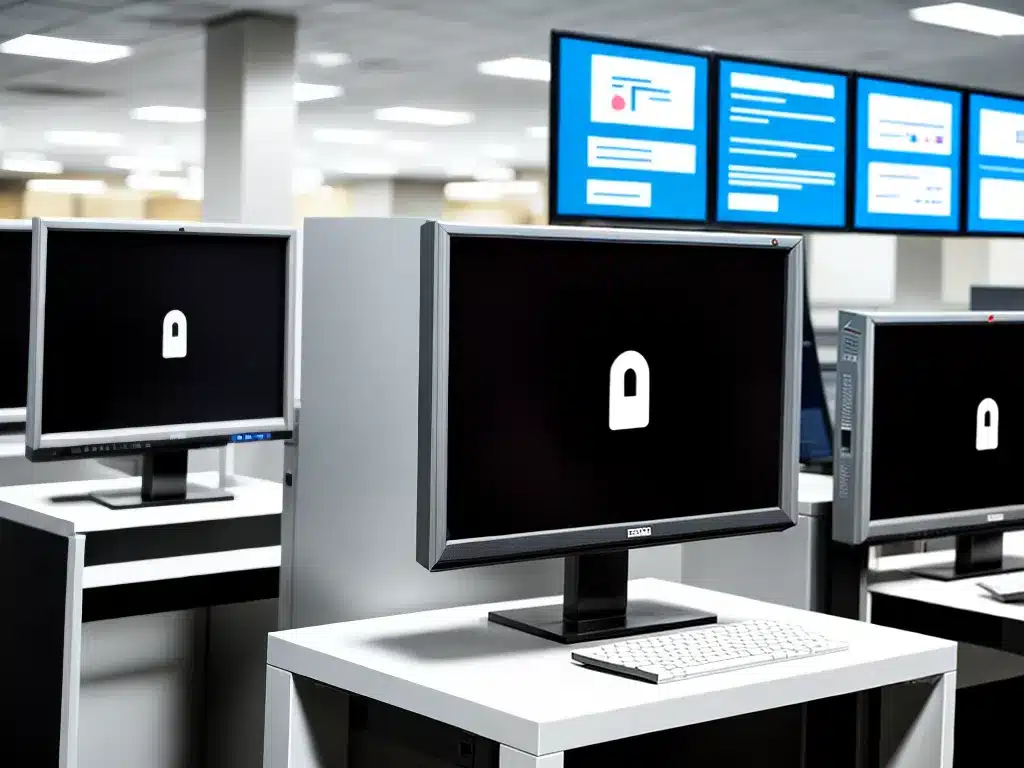
Introduction
Public computers and kiosks provide convenient access to information and services for people on the go. However, using shared devices also comes with potential security risks that users should be aware of. In this article, I will discuss the various threats posed by public computers and kiosks and provide tips on how to use them more safely.
Malware and Spyware
One of the biggest dangers of using public computers is malware infection. Public devices are used by many different people, some of whom may access malicious sites or download infected files. This leaves the computer vulnerable to viruses, spyware, keyloggers and other types of malicious software.
Once installed, malware can record keystrokes, steal login credentials, install additional malicious programs, and transmit personal data to attackers. In the worst cases, infected public computers have been used as part of large botnets to distribute spam emails or launch cyber attacks.
Spyware is a type of malware that tracks user activity without consent. It can monitor browsing habits, capture screenshots, and relay information back to attackers. Public computers infected with spyware essentially become sophisticated surveillance devices.
Phishing and Identity Theft
Public terminals are prime targets for phishing scams that attempt to steal personal information. Phishing websites masked as legitimate sites may retain login credentials entered into them. Keyloggers installed on public computers can also capture usernames, passwords, credit card numbers, and other sensitive details.
With enough personal information, cybercriminals can steal identities, make fraudulent purchases, or even take out loans in the victim’s name. Identity theft can have long-lasting financial and legal consequences for those affected.
Eavesdropping
When using public computers, it is difficult to know who might be shoulder surfing or otherwise spying on your activity. Shoulder surfers can observe login credentials and other information as it’s entered. Surveillance cameras or over-the-shoulder onlookers may be able to view sensitive data displayed on the screen.
Keystroke loggers can record everything typed on a keyboard, including messages, search terms, logins, and financial details. This data can then be accessed by attackers.
Unsecured Networks
Public computers and kiosks often connect to unsecured Wi-Fi networks that are easy for experienced hackers to infiltrate. Any information sent over a compromised network can potentially be intercepted, including account numbers, passwords, emails, and private communications.
Even on secured networks, traffic passing through public terminals could be more easily sniffed by attackers with physical access to the device.
Tips for Safer Use
-
Avoid entering personal information or logging into important accounts on public computers when possible.
-
Be wary of shoulder surfers and cameras when using public devices.
-
Only visit sites secured with HTTPS encryption to prevent snooping of traffic.
-
Never enable browsers to save passwords on public machines.
-
Refrain from online shopping or banking on public computers.
-
Use your own 4G/cellular connection instead of public Wi-Fi whenever possible.
-
Make sure email services and accounts require two-factor authentication.
-
Clear browser caches and histories after using a public computer to cover tracks.
-
Use a VPN connection to encrypt traffic when connecting via public Wi-Fi.
-
Consider using disposable virtual credit cards for required purchases.
-
Keep device logins and sensitive tasks on your personal computer or smartphone.
The Future of Public Computer Security
To help mitigate the risks posed by public computers, providers are starting to implement more advanced security measures. These include:
-
Diskless workstations – No data is stored locally on the public device.
-
Virtualization – A new virtual machine instance is provided for each user session.
-
Live OS – The device boots a temporary operating system from a encrypted drive or network source.
-
Automated malware scanning – Monitoring software repeatedly scans for threats and self-heals.
-
Network segmentation – Public machines are placed on an isolated network with restricted access.
-
Access controls – Users must verify their identity to use the public device.
-
Hardware-based security – Tamper-resistant cases and component-level protections prevent device tampering.
While these solutions help, risks still remain. The most vigilant approach is for users to exercise caution and avoid sensitive activities when using public terminals. With greater public awareness, providers will also be pushed to prioritize security in their public computer offerings.
Conclusion
Public computers and kiosks provide convenient access to online services, but also carry risks like malware, phishing scams, eavesdropping, and unsecured networks. Users should avoid logging into important accounts, entering sensitive information, or accessing unsecured sites on public devices when possible. Care should also be taken to avoid shoulder surfing and utilize privacy filters when available. While security measures are improving, it’s ultimately up to the user to exercise sound judgement in order to minimize risks. With vigilance and caution, public computers can still be used in a reasonably secure manner.












